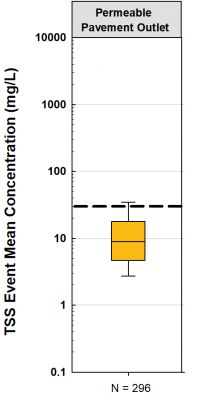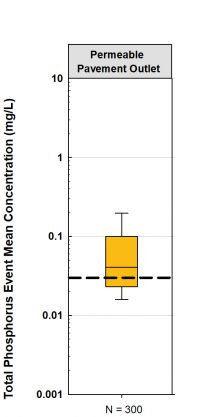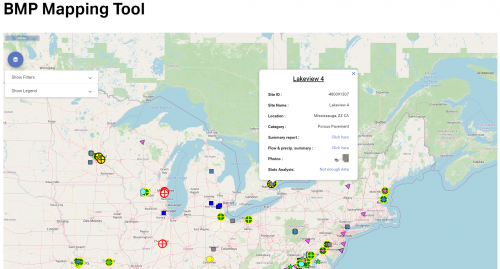Difference between revisions of "Permeable pavements: Performance"
(Created page with "{{TOClimit|2}} ==TSS Reduction== 200px|thumb The performance results for Permeable Pavement/Porous Asphalt: Life Cycle Costs practices, located within TRCA's watershed originate from three primary sites: *Kortright Centre Parking Lot *Seneca College *IMAX Corporation, head office The mean performance value recorded at the outlet for Permeable Pavement practices' ability to remove Total Suspended Sediments (TSS) was was ca...") |
Dean Young (talk | contribs) |
||
| (11 intermediate revisions by one other user not shown) | |||
| Line 4: | Line 4: | ||
==TSS Reduction== | ==TSS Reduction== | ||
[[File:TSS - permeable pavement.JPG|200px|thumb]] | [[File:TSS - permeable pavement.JPG|200px|thumb]] | ||
The performance results for [[Permeable | The performance results for [[Permeable pavement]]/[[Porous Asphalt: Life Cycle Costs]] practices, located within TRCA's watershed originate from three primary sites: | ||
*Kortright Centre Parking Lot | *Kortright Centre Parking Lot | ||
*Seneca College | *Seneca College | ||
| Line 19: | Line 19: | ||
[[File:TP - permeable pavement.JPG|200px|thumb]] | [[File:TP - permeable pavement.JPG|200px|thumb]] | ||
==Phosphorus Reduction== | ==Phosphorus Reduction== | ||
The performance results for [[Permeable | The performance results for [[Permeable pavement]]/[[Porous Asphalt: Life Cycle Costs]] practices, located within TRCA's watershed originate from three primary sites: | ||
*Kortright Centre Parking Lot | *Kortright Centre Parking Lot | ||
*Seneca College | *Seneca College | ||
| Line 27: | Line 28: | ||
The mean performance value recorded at the outlet for Permeable Pavement practices' ability to remove Total [[Phosphorus]] (TP) was calculated based on 300 separate recordings between 2005-2007, and 2010-2017 amongst the three sites previously mentioned. | The mean performance value recorded at the outlet for Permeable Pavement practices' ability to remove Total [[Phosphorus]] (TP) was calculated based on 300 separate recordings between 2005-2007, and 2010-2017 amongst the three sites previously mentioned. | ||
As can be seen in the corresponding boxplot, the mean performance removal efficiency of the | As can be seen in the corresponding boxplot, the mean performance removal efficiency of the permeable pavement practices monitored are not meeting the acceptable upper extent range of nutrients as of 0.03 mg/L (30 µg/L) (Environment Canada, 2004<ref name="example1">Environment Canada. (2004). Canadian guidance framework for the management of phosphorus in freshwater systems. Ecosystem Health: Science‐based solutions report no. 1–8. Cat. No. En1–34/8–2004E. </ref>; OMOEE, 1994<ref>Ontario Ministry of Environment and Energy (OMOEE), 1994. Policies, Guidelines and Provincial Water Quality Objectives of the Ministry of Environment and Energy. Queen’s Printer for Ontario. Toronto, ON.</ref>). | ||
The median value of the 355 samples taken was '''0.04 mg/L''' whereas the mean was '''0.08 mg/L''', with | The median value of the 355 samples taken was '''0.04 mg/L''' whereas the mean was '''0.08 mg/L''', with a '''62%''' guideline exceedance. Given the age of most of these practices, more inspection, maintenance and necessary rehabilitation will be needed to ensure they are able to meet the federal and provincial governments' guideline requirement for stormwater quality. | ||
'''Please refer to the [[Phosphorus]] page and the [[additives]] page for more information on how LIDs can reduce contaminant loading in stormwater''' | '''Please refer to the [[Phosphorus]] page and the [[additives]] page for more information on how LIDs can reduce contaminant loading in stormwater''' | ||
| Line 35: | Line 36: | ||
==Recent Performance Research== | ==Recent Performance Research== | ||
*[https:// | *[https://www.waterrf.org/system/files/resource/2020-11/DRPT-4968_0.pdf International Stormwater BMP Database: 2020 Summary Statistics (Clary et al. 2020)] | ||
** | **The International Stormwater Best Management Practices (BMP) Database is a publicly accessible repository for BMP performance monitoring study, design, and cost information. As of December 2019, the BMP Database contains data sets collected over four decades from over 700 BMP studies through the U.S., Canada, Sweden, New Zealand, Australia, China, etc. that are accessible on the project website ([www.bmpdatabase.org]). The performance data for both TSS and TP are as follows within the report: | ||
***Median TSS value of outflow/effluent of stormwater from P.P is 22 mg/L in comparison to 77 mg/L influent levels. These levels are computed using the BCa bootstrap method described by Efron and Tibishirani (1993). This value is below the required CWQG levels for TSS in stormwater. | |||
***Median Total phosphorus (TP) value of outflow/effluent of stormwater from P.P is 0.10 mg/L in comparison to 0.17 mg/L influent levels. These levels are computed using the BCa bootstrap method described by Efron and Tibishirani (1993). This value is below the required federal (Environment Canada, 2004) and provincial (OMOEE, 1994) levels for TP in stormwater ((Clary et al., 2020<ref>Clary, J., Jones, J., Leisenring, M., Hobson, P. and Strecker, E. 2020. International stormwater BMP database 2020 summary statistics. Water Environment & Reuse Foundation.</ref>). | |||
[[File:BMP mapping tool.PNG|thumb|500px|One of STEP's sites located in Mississauga, ON. (Lakeview Neighbourhood), where P.P was installed in residential driveways. Full submission and details to the BMP can be selected on the map viewer and can be viewed [https://igeowater.com/InternationalBMPDBAssets/PDF/Description/00608--DESCP.pdf here.] (International Stormwater BM<P Database, 2021<ref>International Stormwater BMP Database. 2021. BMP Mapping Tool. Retrieved Feb. 28, 2023. https://bmpdatabase.org/bmp-mapping-tool</ref>).]] | |||
*[https:// | *[https://www.sciencedirect.com/science/article/abs/pii/S0959652618335376 (Xie, et al. 2019) - Permeable concrete pavements: A review of environmental benefits and durability.] | ||
** | ** This literature review paper looked at a multitude of studies highlighting the numerous benefits (hydraulic/water quality performance, heat-island mitigative effects, skid resistance ability and winter durability) associated with P.P and discussed some prominent papers' results. A project in Yakima, Washington (Yakima County website, 2012<ref>Yakima County website, 2012. Regional Stormwater Management Program, Project. Low Impact Development Demonstration Project. http://www.yakimacounty. us/stormwater/LID/project.htm.</ref>) compared effluent water samples collected in vaults adjacent to two pavement types (permeable and impermeable). The water samples collected from the P.P plot had significantly lower TSS values when compared to the control, impermeable plot's samples (25 mg/L vs. 320 mg/L). Whereas, Luck et al. (2008<ref>Luck, J.D., Workman, S.R., Coyne, M.S. and Higgins, S.F. 2008. Solid material retention and nutrient reduction properties of pervious concrete mixtures. Biosystems engineering, 100(3), pp.401-408.</ref>, 2009<ref>Luck, J.D., Workman, S.R., Coyne, M.S. and Higgins, S.F. 2009. Consequences of manure filtration through pervious concrete during simulated rainfall events. Biosystems Engineering, 102(4), pp.417-423.</ref>) found P.P to exhibit excellent mitigating characteristics for intensive, nearby agricultural practices (composted beef cattle manure) to help limit the amount of soluble phosphorus and total phosphorus in stormwater runoff (Xie, et al. 2019<ref>Xie, N., Akin, M. and Shi, X., 2019. Permeable concrete pavements: A review of environmental benefits and durability. Journal of cleaner production, 210, pp.1605-1621</ref>). | ||
*[https://www. | *[https://www.sciencedirect.com/science/article/abs/pii/S0043135419308450 (Ostrom and Davis, 2019) - Evaluation of an enhanced treatment media and permeable pavement base to remove stormwater nitrogen, phosphorus, and metals under simulated rainfall.] | ||
** | **This article by Ostrom and Davis, 2019, out of the University of Maryland discusses a new treatment media that can be developed to improve dissolved pollutant removal and retention in permeable pavement practices. This structural media is called "High Permeability Media Mixture (HPMM)", and was designed as a base material for P.P practices that can retain phosphorus in stormwater that enters the practice. The results of this study showed that effluent total dissolved phosphorus (TDP) levels was lower than influent for all samples (12 storms). Removal efficiency was between 48 - 98% effective with a median effluent level of 0.045 - 0.05 mg/L (dependent upon the 3 configurations used) in comparison to TDP event mean concentrations of 0.22 mg/L (Ostrom and Davis, 2019<ref>Ostrom, T.K. and Davis, A.P. 2019. Evaluation of an enhanced treatment media and permeable pavement base to remove stormwater nitrogen, phosphorus, and metals under simulated rainfall. Water research, 166, p.115071.)</ref>. | ||
==References== | ==References== | ||
Latest revision as of 20:15, 20 March 2023
TSS Reduction[edit]
The performance results for Permeable pavement/Porous Asphalt: Life Cycle Costs practices, located within TRCA's watershed originate from three primary sites:
- Kortright Centre Parking Lot
- Seneca College
- IMAX Corporation, head office
The mean performance value recorded at the outlet for Permeable Pavement practices' ability to remove Total Suspended Sediments (TSS) was was calculated based on 296 separate recordings between 2005-2007, and 2010-2017 amongst the three sites previously mentioned.
As can be seen in the corresponding boxplot the mean performance removal efficiency of the permeable pavement practices monitored are well below the suggested guideline of 30 mg/L (Canadian Water Quality Guideline (CWQG), or (background (assumed at <5 mg/L)+ 25 mg/L for short term (<24 hour) exposure) (CCME, 2002[1]; (TRCA, 2021[2]).
The median value of the 301 samples taken was 8.95 mg/L whereas the mean was 17.10 mg/L, with a 12% guideline exceedance.
Phosphorus Reduction[edit]
The performance results for Permeable pavement/Porous Asphalt: Life Cycle Costs practices, located within TRCA's watershed originate from three primary sites:
- Kortright Centre Parking Lot
- Seneca College
- IMAX Corporation, head office
The mean performance value recorded at the outlet for Permeable Pavement practices' ability to remove Total Phosphorus (TP) was calculated based on 300 separate recordings between 2005-2007, and 2010-2017 amongst the three sites previously mentioned.
As can be seen in the corresponding boxplot, the mean performance removal efficiency of the permeable pavement practices monitored are not meeting the acceptable upper extent range of nutrients as of 0.03 mg/L (30 µg/L) (Environment Canada, 2004[3]; OMOEE, 1994[4]).
The median value of the 355 samples taken was 0.04 mg/L whereas the mean was 0.08 mg/L, with a 62% guideline exceedance. Given the age of most of these practices, more inspection, maintenance and necessary rehabilitation will be needed to ensure they are able to meet the federal and provincial governments' guideline requirement for stormwater quality.
Please refer to the Phosphorus page and the additives page for more information on how LIDs can reduce contaminant loading in stormwater
Recent Performance Research[edit]
- International Stormwater BMP Database: 2020 Summary Statistics (Clary et al. 2020)
- The International Stormwater Best Management Practices (BMP) Database is a publicly accessible repository for BMP performance monitoring study, design, and cost information. As of December 2019, the BMP Database contains data sets collected over four decades from over 700 BMP studies through the U.S., Canada, Sweden, New Zealand, Australia, China, etc. that are accessible on the project website ([www.bmpdatabase.org]). The performance data for both TSS and TP are as follows within the report:
- Median TSS value of outflow/effluent of stormwater from P.P is 22 mg/L in comparison to 77 mg/L influent levels. These levels are computed using the BCa bootstrap method described by Efron and Tibishirani (1993). This value is below the required CWQG levels for TSS in stormwater.
- Median Total phosphorus (TP) value of outflow/effluent of stormwater from P.P is 0.10 mg/L in comparison to 0.17 mg/L influent levels. These levels are computed using the BCa bootstrap method described by Efron and Tibishirani (1993). This value is below the required federal (Environment Canada, 2004) and provincial (OMOEE, 1994) levels for TP in stormwater ((Clary et al., 2020[5]).
- The International Stormwater Best Management Practices (BMP) Database is a publicly accessible repository for BMP performance monitoring study, design, and cost information. As of December 2019, the BMP Database contains data sets collected over four decades from over 700 BMP studies through the U.S., Canada, Sweden, New Zealand, Australia, China, etc. that are accessible on the project website ([www.bmpdatabase.org]). The performance data for both TSS and TP are as follows within the report:
- (Xie, et al. 2019) - Permeable concrete pavements: A review of environmental benefits and durability.
- This literature review paper looked at a multitude of studies highlighting the numerous benefits (hydraulic/water quality performance, heat-island mitigative effects, skid resistance ability and winter durability) associated with P.P and discussed some prominent papers' results. A project in Yakima, Washington (Yakima County website, 2012[7]) compared effluent water samples collected in vaults adjacent to two pavement types (permeable and impermeable). The water samples collected from the P.P plot had significantly lower TSS values when compared to the control, impermeable plot's samples (25 mg/L vs. 320 mg/L). Whereas, Luck et al. (2008[8], 2009[9]) found P.P to exhibit excellent mitigating characteristics for intensive, nearby agricultural practices (composted beef cattle manure) to help limit the amount of soluble phosphorus and total phosphorus in stormwater runoff (Xie, et al. 2019[10]).
- (Ostrom and Davis, 2019) - Evaluation of an enhanced treatment media and permeable pavement base to remove stormwater nitrogen, phosphorus, and metals under simulated rainfall.
- This article by Ostrom and Davis, 2019, out of the University of Maryland discusses a new treatment media that can be developed to improve dissolved pollutant removal and retention in permeable pavement practices. This structural media is called "High Permeability Media Mixture (HPMM)", and was designed as a base material for P.P practices that can retain phosphorus in stormwater that enters the practice. The results of this study showed that effluent total dissolved phosphorus (TDP) levels was lower than influent for all samples (12 storms). Removal efficiency was between 48 - 98% effective with a median effluent level of 0.045 - 0.05 mg/L (dependent upon the 3 configurations used) in comparison to TDP event mean concentrations of 0.22 mg/L (Ostrom and Davis, 2019[11].
References[edit]
- ↑ Canadian Council of Ministers of the Environment (CCME). 2002. Canadian water quality guidelines for the protection of aquatic life: Total particulate matter. In: Canadian Environmental Quality Guidelines, Canadian Council of Ministers of the Environment, Winnipeg
- ↑ TRCA. 2021. Spatial Patterns (2016-2020) and Temporal Trends (1966-2020) in Stream Water Quality across TRCA’s Jurisdiction Prepared by Watershed Planning and Ecosystem Science. https://trcaca.s3.ca-central-1.amazonaws.com/app/uploads/2021/10/29113334/2016-2020-SWQ-Report-v11_FINAL_AODA-FA.pdf
- ↑ Environment Canada. (2004). Canadian guidance framework for the management of phosphorus in freshwater systems. Ecosystem Health: Science‐based solutions report no. 1–8. Cat. No. En1–34/8–2004E.
- ↑ Ontario Ministry of Environment and Energy (OMOEE), 1994. Policies, Guidelines and Provincial Water Quality Objectives of the Ministry of Environment and Energy. Queen’s Printer for Ontario. Toronto, ON.
- ↑ Clary, J., Jones, J., Leisenring, M., Hobson, P. and Strecker, E. 2020. International stormwater BMP database 2020 summary statistics. Water Environment & Reuse Foundation.
- ↑ International Stormwater BMP Database. 2021. BMP Mapping Tool. Retrieved Feb. 28, 2023. https://bmpdatabase.org/bmp-mapping-tool
- ↑ Yakima County website, 2012. Regional Stormwater Management Program, Project. Low Impact Development Demonstration Project. http://www.yakimacounty. us/stormwater/LID/project.htm.
- ↑ Luck, J.D., Workman, S.R., Coyne, M.S. and Higgins, S.F. 2008. Solid material retention and nutrient reduction properties of pervious concrete mixtures. Biosystems engineering, 100(3), pp.401-408.
- ↑ Luck, J.D., Workman, S.R., Coyne, M.S. and Higgins, S.F. 2009. Consequences of manure filtration through pervious concrete during simulated rainfall events. Biosystems Engineering, 102(4), pp.417-423.
- ↑ Xie, N., Akin, M. and Shi, X., 2019. Permeable concrete pavements: A review of environmental benefits and durability. Journal of cleaner production, 210, pp.1605-1621
- ↑ Ostrom, T.K. and Davis, A.P. 2019. Evaluation of an enhanced treatment media and permeable pavement base to remove stormwater nitrogen, phosphorus, and metals under simulated rainfall. Water research, 166, p.115071.)


